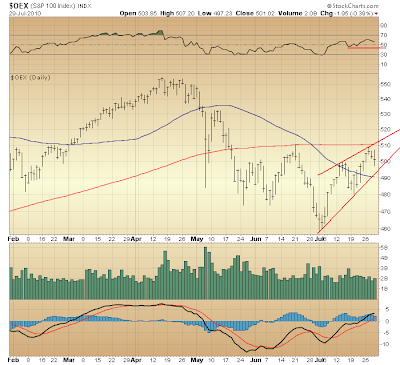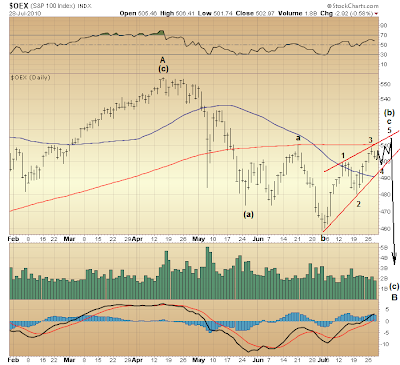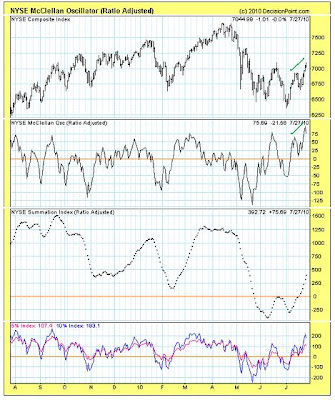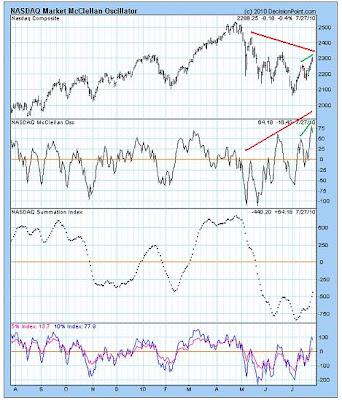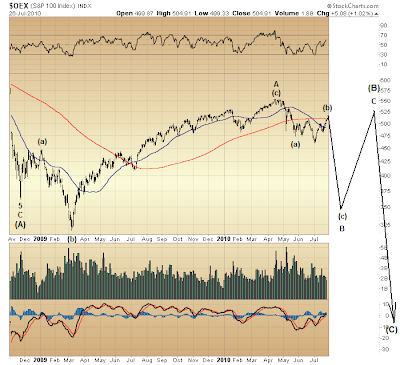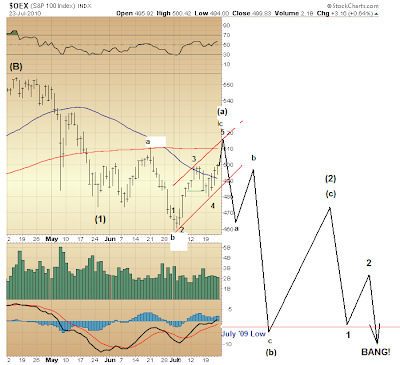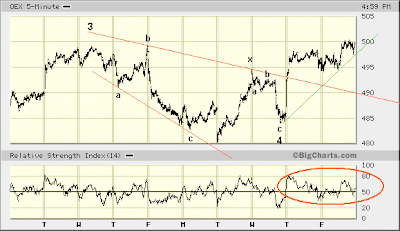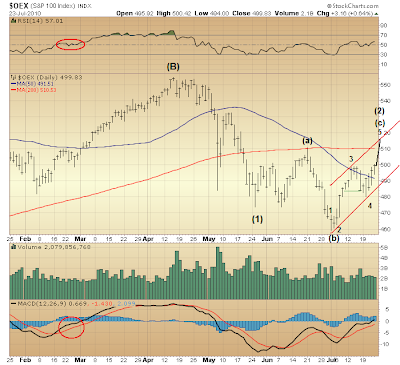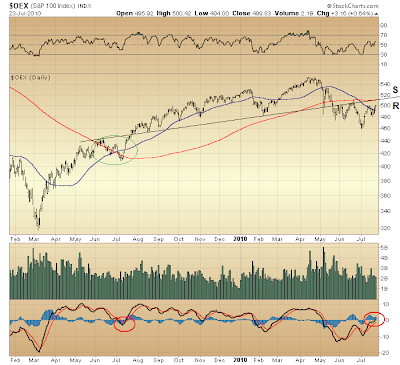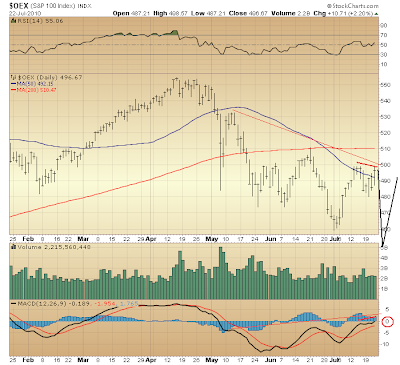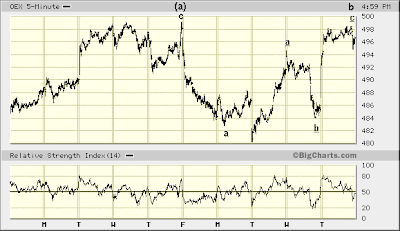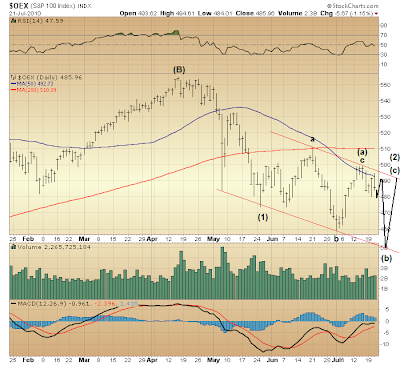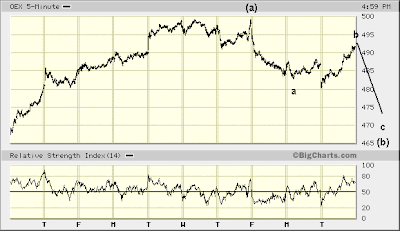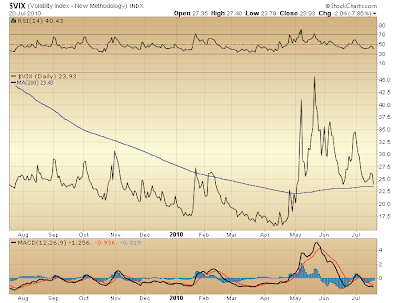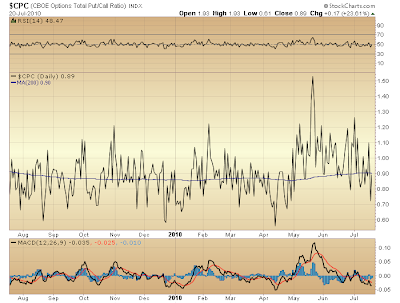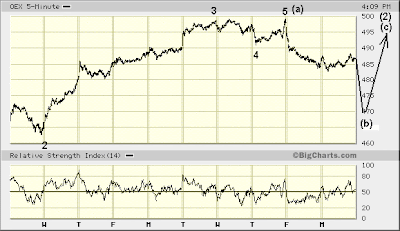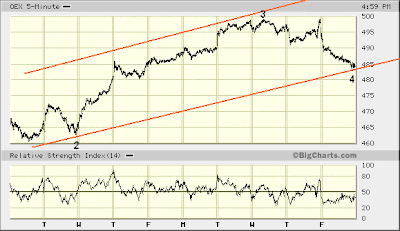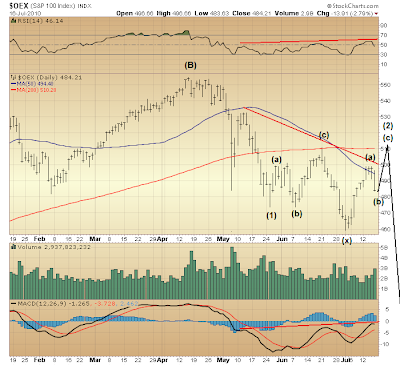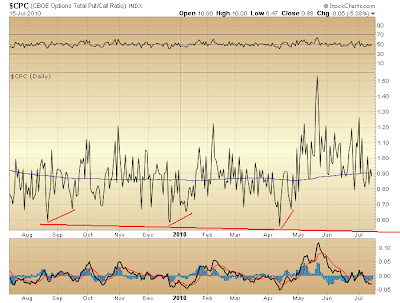Continuing similarity to technical conditions leading into April 2010 top are further substantiating my current Elliott Wave view, raising odds a steep market decline is just around the corner...

Noted a couple weeks ago were similarities to technical conditions at the time with the late-February period. Presently, taking a dynamic perspective of momentum (MACD) we see that, further similarity to that earlier period is being evidenced.
To wit MACD is coming into its 9-day moving average, much as occurred mid-March during formation of wave iv of 5 of (c) of A. Oddly enough, another forth wave — wave 4 of c of (b) — presently is thought forming.
Technical strength coincident with the rise of wave 3 of c of (b) (see Tuesday's "Setting Up for a Giant Letdown") now is being followed by several first-signs of technical weakness (with MACD being but one instance). This substantiates the possibility that, a rising wedge could be forming off June 29th bottom. There's more...
Remember how over the course of the market's counter-trend rally off March '09 bottom, every third wave's completion coincided with a pickup — a spike — in volume? We saw this last as wave iii of 5 of (c) of A completed in March 2010. This was a very notable pattern throughout the formation of wave (c) of A from March '09.
Well, given good technical reason to suppose the above wave count off June 29th bottom is valid, where's the volume spike at the conclusion of wave 3 of c of (b) (from Tuesday, July 27th, on)? Volume this week, relatively speaking, has been muted.
But wait... What's that at the peak of wave 1 a couple weeks ago? A spike in volume.
Wave 1, of course, is a first wave, not a third wave. Ah, but this wave 1 is thought to be forming the initial move up in a rising wedge — a "special" Elliott wave form whose impulse waves (i.e. waves 1, 3, and 5) subdivide in three waves (i.e. a-b-c) rather than five. So, the volume spike came at the conclusion of wave c of 1 — a third wave.
So, then, that volume did not spike at the conclusion of wave 3 (Tuesday, July 27th) ... following an advance whose relative technical strength substantiates this very wave count ... what is this suggesting?
Well, let's see...
At the conclusion of successive third waves throughout the formation of wave (c) of A from March '09 - April '10 volume diminished ... suggesting that, every step of the way higher shares strong hands needed distributing were becoming fewer in number ... and now we see no volume spike at the conclusion of a technically strong (relatively speaking) wave 3 of c of (b).
Do my eyes deceive? It appears strong hands may have completed their distribution!
All this, of course, "fits" the near-term view forward, too. If strong hands are fairly done distributing their shares ... and they are not, contrarily, accumulating shares ... then a momentary, Wile E. Coyote levitation over cliff's edge would be in keeping with what remains to be seen of the rising wedge thought forming off June 29th bottom ... with gravity's invariable effect taking hold thereafter.
Distribution done, eh? What might this mean when wave (c) of B of (B) completes its upcoming, hard move down (quite possibly putting March '09 lows in the crosshairs before election day)?
On Monday I wondered whether wave C of (B) [up] (following the upcoming wave (c) of B of (B) down) will be "a screamer with a short life, or a slow, tired grind higher possibly lasting well into next year?"
Well, if distribution more or less is in fact done, then chances are good, it seems, a slow grind higher it will be. However, understanding the magnitude of systemic risk at present and believing even white shoe firms are among weak hands (yet possessing considerable power nevertheless), a screamer with a short life rather seems more likely.
Indeed, this probability might better be thought baked in the cake, so long as those champion empiricist Monetarist Monkeys of ours remain at the top of their game.

* * * * *
© The Risk Averse Alert — Advocating a patient, disciplined approach to stock market investing. Overriding objective is limiting financial risk. Minimizing investment capital loss is a priority.
Analysis centers on the stock market's path of least resistance. Long-term, this drives a simple strategy for safely investing a 401(k) for maximum profit. Intermediate-term, investing with stock index tracking-ETFs (both their long and short varieties) is advanced. Short-term, stock index options occasionally offer extraordinary profit opportunities when the stock market is moving along its projected path.
Nothing is set in stone. Nor is the stock market's path of least resistance always known. More often than not, there are no stock index option positions recommended.
 There's an easy way to boost your investment discipline...
There's an easy way to boost your investment discipline...Get Real-Time Trade Notification!
